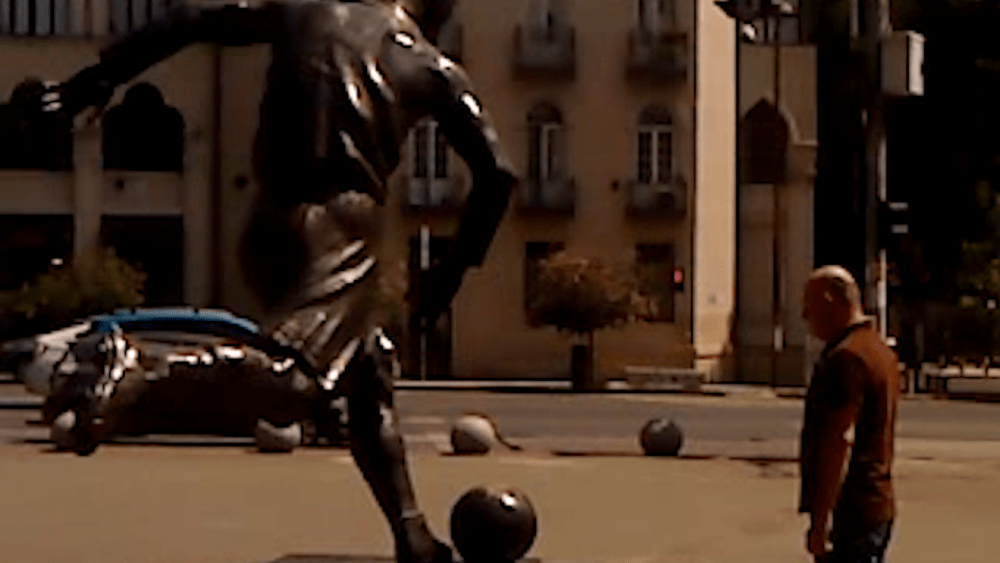In Alexandre Koberidze‘s 2021 breakout “What Do We See When We Look at the Sky?” the audience is politely requested to momentarily close their eyes. The Georgian director’s unassumingly epic follow-up, “Dry Leaf,” contains no such exhortation, and for good reason: It was entirely shot on an obsolete cameraphone, resulting in images so deliberately indistinct and squelchy that you’ll want to open your eyes wider in order to puzzle them out. Defiantly peculiar and only a little overlong at three hours, “Dry Leaf” is a joy for devotees of the strange, singular and sometimes transcendent. It’s a movie to ride shotgun alongside, with the windows down on a lazy trip to nowhere in particular, that ends up taking you everywhere in particular.
Koberidze opens with a montage of cats, foot traffic, street dogs twitching in their sleep, statues and trees casting long shadows across buildings. It’s only a couple of minutes long but when it ends – on what is, irrefutably, a dry leaf – you may find your brain already starting to reformat its cinematic notions of ‘beautiful’ and ‘ugly’. In almost any other context, the mushy, bitmapped backgrounds and granulated edges (rendered by a Sony Ericsson phone that was discontinued in 2011) would look repellent, like mistakes. Here, as accompanied by a stretch of a fantastic score (by Koberidze’s brother Giorgi) that sounds like villains chasing damsels in a silent-movie caper, they look romantic, like mysteries.
The slim story goes that Irakli (David Koberidze, the director’s father; this is a family affair), a teacher at the local sports university, has recently received a letter from Lisa, his sports-photographer daughter, telling him she’s going away and not to follow. Ignoring that second part, Irakli contacts Lisa’s editor and discovers that her as-yet-unfinished assignment is a photo essay on the crumbling football pitches of rural Georgia. He resolves to retrace her itinerary.
He’s joined by Levan (Otar Nijaradze), Lisa’s companion on her initial cross-country trip. Levan’s memory is bad, however, and he often forgets exactly where they went, which is a problem. Also, Levan is invisible, which is not. It is a condition he shares with many of the people he and Irakli encounter, and whether these budget-friendly characters are invisible only to us, or whether everyone they meet is simply too polite to mention their non-corporeal form, is never clearly outlined. Nothing is, in this diffuse, glimmering patchwork world. Even the obviously tangible Irakli can, through a glitch in the camera’s rustic diodes, all but vanish into the fuzz of a forest or a field. It’s like the mood of warm, wry nostalgia for people, places and pastimes disappeared and disappearing, is bleeding through into images always on the verge of degrading into indecipherability.
Are your eyes playing tricks on you, or does every exploded pixel reveal as well as conceal? The answer is yes and yes. Levan and Irakli’s journey through Georgia’s many overgrown village football fields, where rusting goalposts stand like totem poles, becomes almost Beckettian in its futility: No one has seen Lisa. But each polite knockback and odd digression throws out at least one casually sublime spark. A plate of ripe apricots on a table is a sudden Dutch Master still life. A low afternoon sun means Irakli passes frame to be followed, seconds later, by his shadow. A dark patch beside a window opens green eyes and we realize a black cat has been sitting on the sill all along. (This sudden feline appearance mirrors the sudden feline disappearance in “What Do We See”; perhaps this mystical black cat is the uncanny portal from one Koberidze universe to the other?) And it’s not only cats. Flora and fauna abound and interacting with all of it, there’s Irakli, the type of guy who keeps kibble in the car to feed passing mutts, and who delays his departure from one village to say goodbye to a donkey.
So though the score at times evokes folk horror, and everything from “Blow-Up” to true-crime CCTV footage has cued us to fear the grainy ambiguities of the distorted, decomposed image, there’s never much peril here. Irakli’s search is less mission than meander, one that only lags during a slightly repetitious late stretch, before Koberidze gets us back. Depositing us neatly between the goalposts of his own devising he mimics the trajectory of a “dry leaf” — an arcane term for a certain spectacular football shot, where the ball arcs over, say, a goalkeeper’s head, before dropping down, nearly vertically, into the net.
There’s no question “Dry Leaf” presents a paradox. The pleasures of this uniquely enjoyable movie may be lost on the small screen where its images will simply look muddy. So, made on the tiniest of cameras, it needs the biggest of screens even though the height of its action is a cat eating raspberries. But it’s also a pioneering work that uses old, ephemeral tech to invent new, eternal cinema. The film is so persuasive of its own whimsical worldview that to emerge 186 minutes later is to feel slightly attacked by the garish, hi-def sharpness of reality, and to wonder where all the wonder has gone.

